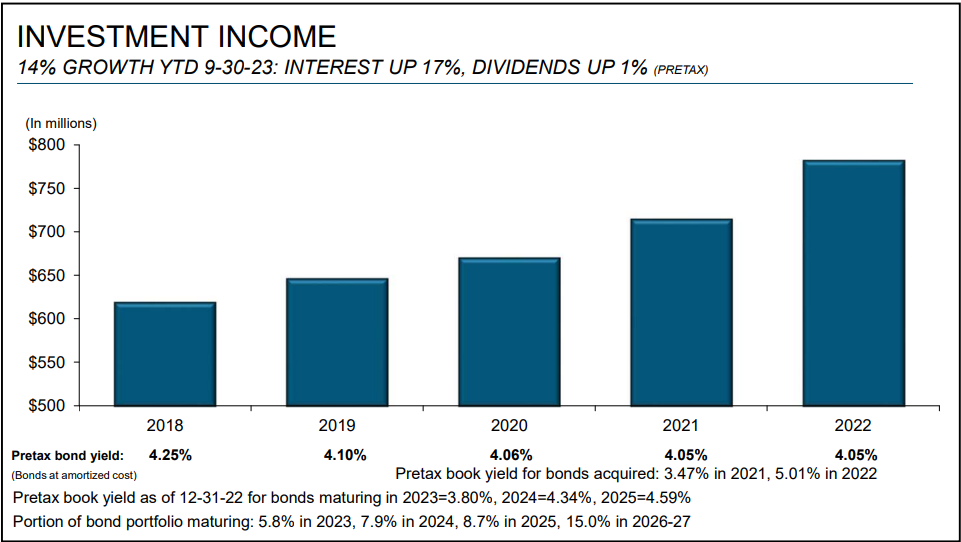Updated on April 22nd, 2024 by Bob Ciura
Every year, we individually review each of the Dividend Aristocrats, a group of S&P 500 Index companies that have raised their dividends for at least 25 consecutive years.
The Dividend Aristocrat we’ll be discussing here is Cincinnati Financial (CINF).
Cincinnati Financial has grown its dividend for 64 years in a row, giving it one of the longest dividend growth streaks in the stock market.
It is on the Dividend Aristocrats list, a group of stocks in the S&P 500 Index with 25+ consecutive years of dividend increases.
You can see our full list of all 68 Dividend Aristocrats, along with important metrics like dividend yields and P/E ratios, by clicking on the link below:
Disclaimer: Sure Dividend is not affiliated with S&P Global in any way. S&P Global owns and maintains The Dividend Aristocrats Index. The information in this article and downloadable spreadsheet is based on Sure Dividend’s own review, summary, and analysis of the S&P 500 Dividend Aristocrats ETF (NOBL) and other sources, and is meant to help individual investors better understand this ETF and the index upon which it is based. None of the information in this article or spreadsheet is official data from S&P Global. Consult S&P Global for official information.
Not only that, but Cincinnati Financial is also a member of the Dividend Kings, an even more exclusive group than the Dividend Aristocrats. Dividend Kings have grown their dividends for 50+ consecutive years.
There are just 54 Dividend Kings.
Cincinnati Financial’s dividend track record is legendary. This article will discuss whether the stock is a buy today.
Business Overview
Cincinnati Financial is an insurance company, founded in 1950. It offers business, home, and auto insurance, as well as financial products including life insurance, annuities, and property and casualty insurance. Revenue is derived from five sources, with agencies across 46 states.
The company has more than 2,000 agency relationships with over 3,000 locations. Many of them have a meaningful market share as well, as Cincinnati Financial has grown over the years.

Source: Investor Presentation
The company has a profitable business model. Instead of focusing solely on high-margin products, Cincinnati Financial is willing to write lower-margin policies. It earns a high level of profit by issuing high volumes and taking market share.
As an insurance company, Cincinnati Financial makes money in two ways. It earns income from premiums on policies written, and also by investing its float, the large sum of premium income not paid out in claims.
Indeed, much of the company’s cash is invested in common stocks as a way to grow book value over time, with no single stock making up more than 5% of the investment portfolio.
To that end, Cincinnati Financial’s book value is more sensitive to stock market performance than some of its peers, which invest their float exclusively on bonds. Of course, this strategy works very well during bull markets.
The favorable combination of premiums and investment gains has led to steady growth over many years, and there should be room for continued growth in the upcoming years.
Growth Prospects
Cincinnati Financial has a positive growth outlook moving forward from new policies written, as well as its equity exposure in the US.
The company has a successful history of growing profits through new policies written, outperforming the industry benchmark, and taking market share as a result. Price increases helped the company grow premium revenue for the past several years.
Due to the government fiscal stimulus in response to the pandemic and the war in Ukraine, inflation surged and has remained elevated. As a result, the Fed is in the process of raising interest rates aggressively in order to lower the inflation rate.
As the Fed has clearly prioritized restoring inflation to its long-term target around 2%, it is likely to achieve its goal sooner or later. In the meantime, high interest rates are not necessarily a bad thing for insurers, as their portfolio yields will increase.

Source: Investor Presentation
On February 19th, 2024, Cincinnati Financial reported fourth-quarter and full-year financial results. Fourth-quarter net income rose to $1.183 billion, or $7.50 per share, compared to $1.013 billion, or $6.41 per share, in 2022.
Full-year results saw a substantial turnaround, with net income reaching $1.843 billion, or $11.66 per share, compared to a net loss of $487 million, or $3.06 per share, in 2022.
Noteworthy financial strength was indicated by a 78% increase in fourth-quarter 2023 non-GAAP operating income to $359 million, or $2.28 per share, and a 42% rise for the full year, totaling $952 million, or $6.03 per share.
Book value per share reached $77.06 by the end of December 2023, up $9.85 since the close of 2022. Additionally, the value creation ratio for the full year 2023 improved significantly to 19.5%, compared to a negative 14.6% in 2022. Revenue data showcased positive trends, with earned premiums growing by 10% in the fourth quarter and full year of 2023.
Investment income, net of expenses, increased by 15% in the fourth quarter and 14% for the full year. Total revenues exhibited an 8% growth in the fourth quarter and a 53% growth rate for the full year.
The core insurance operations highlighted an 87.5% combined ratio for property casualty in the fourth quarter of 2023, showcasing improvement from 94.9% in the same period of 2022.
Competitive Advantages & Recession Performance
There aren’t many identifiable competitive advantages in the insurance industry, other than brand recognition.
There are generally low barriers to entry in insurance, which leads to fierce competition, as differentiation is very difficult. The good news for Cincinnati Financial is that it thrives on price competition. Cincinnati Financial has decades of experience and has built a close relationship with its customers.
That said, insurance companies are not immune to economic downturns. Cincinnati Financial does not have a recession-resistant business model. In fact, it is more sensitive to recessions than other insurers due to the relatively high exposure of its investment portfolio to the stock market. Earnings-per-share during the Great Recession are below:
- 2007 earnings-per-share of $3.54
- 2008 earnings-per-share of $2.10 (41% decline)
- 2009 earnings-per-share of $1.32 (37% decline)
- 2010 earnings-per-share of $1.68 (27% increase)
Earnings declined significantly from 2008-2010. Insurers like Cincinnati Financial typically sell fewer policies during recessions, along with poor performance of their investment portfolios when markets decline.
That said, the company did remain profitable during the recession, which allowed it to continue raising its dividend every year. And, the company enjoyed a strong recovery in 2010 and thereafter, once the recession ended.
Valuation & Expected Returns
Based on expected earnings-per-share of $6.23 for 2024, Cincinnati Financial stock trades for a price-to-earnings ratio of 19.4. We see fair value at 20 times earnings, meaning it appears that shares are slightly undervalued at this point.
If the valuation multiple expands to our fair value P/E, future returns would be increased by 0.6% per year over the next five years.
Earnings growth and dividends will add to shareholder returns. We forecast 6% annual earnings growth for Cincinnati Financial. In addition, the stock has a current dividend yield of 2.7%.
Cincinnati Financial’s dividend is secure. The payout ratio currently stands at 52% expected for 2024, which indicates sufficient coverage of the dividend.
Given 6.0% expected EPS growth, the 2.7% dividend and a 0.6% annualized valuation return, the stock is expected to offer total returns of 9.3% per year over the next five years. This is a strong expected rate of return, but is just under our 10% threshold for a buy rating.
Final Thoughts
Cincinnati Financial is a high-quality dividend stock that has delivered compelling results for shareholders in the past. The company is not a high-growth name, though, and we believe that earnings will rise at a meager mid-single-digit pace.
Cincinnati Financial is trading at a rich valuation level compared to what seems justified based on its growth outlook and historical valuation.
As a result, the shares earn a hold recommendation at the current valuation level.
If you are interested in finding high-quality dividend growth stocks suitable for long-term investment, the following Sure Dividend databases will be useful:
- The Dividend Achievers List: a group of stocks with 10+ years of consecutive dividend increases.
- The Dividend Kings List: considered to be the best-of-the-best among dividend growth stocks, the Dividend Kings are a group of exceptional dividend stocks with 50+ years of consecutive dividend increases.
- The Blue Chip Stocks List: contains stocks on either the Dividend Achievers, Dividend Aristocrats, or Dividend Kings list.
- The Monthly Dividend Stocks List: contains stocks that pay dividends each month, for 12 payments per year.
- The High Dividend Stocks List: high dividend stocks are suited for investors that need income now (as opposed to growth later) by listing stocks with 5%+ dividend yields.
The major domestic stock market indices are another solid resource for finding investment ideas. Sure Dividend compiles the following stock market databases and updates them monthly:
